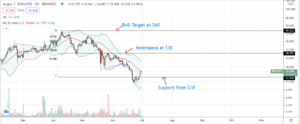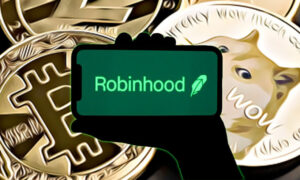
USDC, USDT, BUSD, PAX, TrueUSD, and DAI are all examples of stablecoins that have recently gained popularity. They have an issue with price stability and liquidity (particularly decentralized stablecoins). When MakerDAO reduced its stability charge to 5.5 percent, many customers of Compound (which had an interest rate of 11 percent at the time) decided to stay because they had taken out a loan in DAI and changing DAI to USDC is a costly procedure. At the same time, many DeFi users are eager to lend their stablecoins in exchange for a 5% APR, which is far higher than what traditional banking gives. Users would be hesitant to provide the same money to trading firms that guarantee profits. Curve Finance addresses the issue of lack of liquidity while trading Stablecoins and high costs. Introduction Curve Finance uses liquidity pools and bonding curves to enable high-efficiency stablecoin trading and low-risk rewards for liquidity providers. When trading from one stablecoin to another on Curve, customers are not vulnerable to the price slippage on DEXs. Curve, unlike Uniswap, lends assets on Compound when they aren’t being traded and pays liquidity providers interest on those loans. Curve was created as an alternative to trading stablecoins on general-purpose DEXes like Uniswap, which have algorithms that aren’t designed for such transactions. Curve’s debut resulted in increased liquidity and more competitive prices for stablecoins. As interest rates in money markets changed, DeFi lenders might quickly and efficiently switch from USDT to USDC or USDC to DAI etc. Curve is an Ethereum-based exchange liquidity pool. The Curve is built for incredibly efficient stablecoin trading and low-risk trading fees go to liquidity providers and veCRV holders. Curve currently offers over 40 distinct official liquidity pools, with the tricrypto2 (USDT / wBTC / WETH) and 3pool (DAI / USDC / USDT) being two of the most popular. However, it’s worth noting that pegged asset trading is still a big part of the market. CRV Token CRV is the Curve protocol’s governance token. It is primarily utilized to incentivize liquidity to the platform. The rise in capital benefits Curve users because it gives more trading liquidity and decreases slippage for end-users. Voting, staking, and raising rewards can be gained by using the CRV token. Users can participate in the community and can introduce or vote on proposals. Depositors can obtain 50% of all trading fees generated by the protocol by staking their CRV tokens. Liquidity Providers can use boosting to increase their CRV awards by up to 2.5x. To access all of these features, token owners must lock their CRV in Curve for vote-escrowed CRV (veCRV) in exchange. The longer the CRV is locked in Curve, the more veCRV you received. For example, 1,000 CRV locked for a year produces 250 veCRV, but the exact amount locked for four years produces 1,000 veCRV. As a result, the longer the lock-up period, the greater the user’s voting power and incentives. This ensures that token holders are invested in the protocol’s long-term success. Curve Token Distribution The following groups received CRV tokens as part of the initial token distribution: 61% to pre-CRV liquidity providers with a one-year vesting period; 30% to shareholders (founders and investors) with a 2-4-year vesting period; 3% to team members with a two-year vesting period; and 5% to the community reserve. The remaining 57 % of the overall maximum supply will be given in stages to future liquidity providers as incentives. Despite the original supply of 1.3 billion, the effective circulating quantity of CRV was zero at launch, due to vesting schedules. Based on this timeline, the inflation of released CRV is expected to be large in the next few years. Only 11.2 percent of the supply is in circulation as of March 10, but that number is expected to rise to 3.37 billion in five years. How to Trade on Curve DEX? Similar to most DeFi applications, you have to allow Curve protocol on your wallet to interact with your DAI or USDC balance before you can trade. Select the asset you’d want to convert (for example, USDC) and the amount (for example, 1,000) on the exchange; the exchange rate and quantity you’ll receive (including all slippage and costs) will be displayed. Curve’s value is in its ability to surprise you with its exchange rate. Fees Currently, all pools have a 0.04 percent fee, 50% of which goes entirely to liquidity providers and 50% to veCRV holders. There is no charge for administration. DAO members have power to determine fees and pool specifications. What are Liquidity Pools? Liquidity pools are a type of smart contract that contains a pool of tokens. If you were to make a pool of DAI and USDC, one DAI would equal one USDC. You would have the same number of tokens in the pool, … Continued
The post Curve Protocol : Leading DEX for Stablecoins appeared first on Cryptoknowmics-Crypto News and Media Platform.
- "
- 000
- 11
- access
- administration
- algorithms
- All
- amount
- Another
- applications
- asset
- Assets
- awards
- Banking
- being
- benefits
- Billion
- Block
- boosting
- BUSD
- capital
- charge
- community
- Compound
- contains
- contract
- Costs
- CRV
- curve
- Customers
- DAI
- DAO
- decentralized
- DeFi
- Despite
- Dex
- Display
- distribution
- Effective
- efficient
- example
- exchange
- expected
- Features
- Fees
- finance
- First
- following
- founders
- future
- governance
- High
- holders
- How
- How To
- HTTPS
- incentivize
- Including
- Increase
- increased
- inflation
- interest
- Interest Rates
- Investors
- issue
- IT
- large
- launch
- leading
- Liquidity
- liquidity providers
- Loans
- locked
- MakerDao
- March
- Market
- Markets
- Media
- Members
- money
- most
- Most Popular
- news
- number
- Offers
- official
- owners
- participate
- pax
- platform
- pool
- Pools
- Popular
- power
- price
- profits
- protocol
- provide
- quickly
- Rates
- receive
- Rewards
- similar
- slippage
- smart
- smart contract
- Stability
- stablecoin
- Stablecoins
- Staking
- stay
- success
- supply
- surprise
- Switch
- team
- time
- token
- Tokens
- trade
- Trading
- traditional
- traditional banking
- Transactions
- Uniswap
- USDC
- USDT
- use
- users
- value
- Vesting
- Vote
- Voting
- Vulnerable
- Wallet
- wBTC
- What
- worth
- year
- years
- zero












